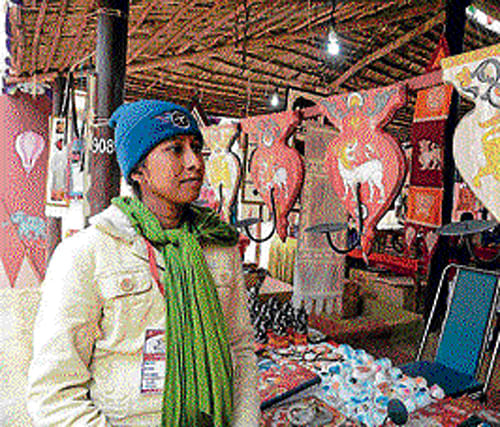
Excitement is writ large on their faces but talk to them and you can feel a sense of apprehension as they try to converse in broken Hindi or English. Comfortable with Sinhala, these craftsmen, who have come all the way from Sri Lanka to participate in the 28th Surajkund International Crafts Mela, were anxious as it was their first time in the country and especially in a fair where buyers of their art are majorly Hindi-speaking.
“I know a little bit of English,” says Thilakaratane Oloboduwa, selling traditional Sri Lankan handmade wooden masks at the fair. Colourful, these masks have grotesque expressions of villainous demons and some comic grimaces. “These masks are used in festivals to decorate the houses and for dance performances. They are made out of the local Kaduru tree timber. Most importantly, each mask is linked to a particular folktale,” explains Thilakaratne, who along with other craftsmen represents Sri Lanka, the partner country of the festival.
Showcasing myriad hues of their culture, PA Duhuthi Athvade, a student of Visual and Performing Arts, Colombo, displays hand-painted candle lamps. Carved out in different shapes from wood, these lamps had intricate designs of lions and Indian deities like Ganesha and Hanuman. “It takes almost a day to finish one lamp,” says Duhuthi, who as a child was so intrigued by the traditional art that she decided to become a painter. “I have specifically learned the temple painting of Sri Lanka, which I have incorporated in the craft,” she says. Interestingly, to give an antique look to the item, Duhuthi has used light black smoke in patches.
Similarly, Shaluth Hasanka displayed his paintings made on velvet cloth. “These paintings are made from rubber fabric which is available in different colours. It almost takes three hours to draw one painting now,” says Shaluth, who has priced the paintings of landscapes, Buddha and animals at Rs 1,000. Likewise, Ratna Vimal Aluthage was busy selling clothes and articles with batik print and Tharandu Chamara selling crockery with symbols of Sri Lankan art.
Meanwhile, artisans from other neighbouring countries were seen wooing the visitors to their stalls. Deepika Rai and Zora Khatri brought the handlooms of Nepal. Stoles made from nettle plant and bamboo is the highlight of their stall. “Fine layers of the stem are used to make these stoles.
The stem is first boiled for two days and thereafter it is beaten so that the stem threads can be easily taken out,” says Deepika. The hard work put in by the craftsmen ensure that these stoles are priced anything between Rs 600 to Rs 1,000.
Mohammed Sayeed Awan showcased the traditional Phulkari work of Pakistan at his stall. “We call it ‘Jisti’ in the local language,” he informs. Sayeed has come from the Khyber Pakhtunkhwa province of Pakistan. Since he is coming to the festival for the second time, he knows exactly what the customers want. “Considering the demands of the customers last year, we have re-defined the patterns. We have tried to present the traditional styles in a modern way to attract more buyers this year,” says Sayeed. So, what are you waiting for ?